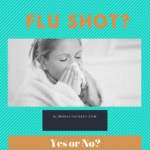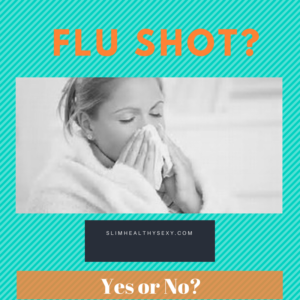flu shot
now browsing by tag
Should You Get The Flu Shot?

Should you get the flu shot? Good question. I think everyone has a right to making this decision for themselves without pressure from doctors, pharmacies, Big Pharma, etc. How about making an informed decision. We are all label readers now. When I go down the aisles in the grocery stores I see people holding up cans and packages carefully reading the ingredients.
So, why don’t people use the same curiosity and caution before pulling up their sleeves and letting a health professional jab their arm with a clear liquid. Boom! It’s quick and happens before you can count to five.
What is the flu anyway? Flu, short for influenza, is a a highly contagious viral infection of the respiratory passages causing fever, and severe aching. I have had the flu once many years ago and it hit me like a 18 wheeler. Wow! I would prefer not to go through that again.
How many people come down with the flu every year? Flu seasons are unpredictable, according to the CDC. Each year, on average, 5 percent to 20 percent of the U.S. population gets the flu and more than 200,000 people are hospitalized from complications.
I was a young adult when I came down with the flu and was able to recover without any medical intervention, however people who are older or have compromised immune systems will have a more difficult time recovering. Some will be hospitalized.
The flu is highly contagious and peaks during the winter months when people are confined in close places due to cold weather.
How reliable is the flu vaccine?
CDC conducts studies each year to determine how well the influenza (flu) vaccine protects against flu illness. While vaccine effectiveness can vary, recent studies show that flu vaccination reduces the risk of flu illness by between 40% and 60% among the overall population during seasons when most circulating flu viruses are well-matched to the flu vaccine.

How are flu vaccines produced?
The most common way that flu vaccines are made is using an egg-based manufacturing process that has been used for more than 70 years. Egg-based vaccine manufacturing is used to make both inactivated (killed) vaccine (usually called the “flu shot”) and live attenuated (weakened) vaccine (usually called the “nasal spray”).
There also is a cell-based production process for flu vaccines, which was approved by FDA in 2012. Until recently, this production process also began with egg-grown CVVs per FDA regulations. However, on August 31,2016, FDA issued an approval for Seqirus, the sole FDA-approved cell-based flu vaccine manufacturer in the United States, to use cell-grown CVVs. The process of creating cell-based flu vaccines involves several steps. First, the World Health Organization (WHO) recommends cell-grown CVVs for distribution to manufacturers. Next, manufacturers inoculate the CVVs into cultured mammalian cells (instead of into eggs) and allow them to replicate for a few days. Then, the virus-containing fluid is collected from the cells and the virus antigen is purified. The manufacturing process continues with purification and testing. Finally, FDA tests and approves the vaccines prior to release and shipment.
There is a third production technology for flu vaccines that was approved for use in the U.S. market in 2013 and that involves using recombinant technology. This production method does not require an egg-grown vaccine virus and does not use chicken eggs at all in the production process. Instead, manufacturers isolate a certain protein from a naturally occurring (“wild type”) recommended vaccine virus (the HA protein, which induces an immune response in people). These proteins are then combined with portions of another virus that grows well in insect cells. This “recombinant” vaccine virus is then mixed with insect cells and allowed to replicate. The flu HA protein is then harvested from these cells and purified. The purified protein is packaged while waiting for FDA testing and approval to release lots. Currently, recombinant flu vaccine is the only 100% egg-free vaccine on the U.S. market.
What ingredients are in a flu shot?
Beta-propiolactone, calcium chloride, dibasic sodium phosphate, egg protein, monobasic potassium phosphate, monobasic sodium phosphate, neomycin sulfate, polymyxin B, potassium chloride, sodium taurodeoxychoalate, thimerosal(multi-dose vials only).
Have you read the MEDICAL MEDIUM yet? 
Medical Medium: Secrets Behind Chronic and Mystery Illness and How to Finally Heal
by Hay House, Inc.
Available on Amazon
Is there mercury in flu shots?
The preservative that we find in multi-dose flu shots is thimerosal (ethylmercury). Vaccine labs add Thimerosal to multidose vaccines because each time a new needle is inserted into the vial, there is a chance of introducing microbes into the vaccine and contaminating it.
Mercury is a neurotoxin. Neurotoxins are substances that are poisonous or destructive to nerve tissue. Neurotoxins are an extensive class of exogenous chemical neurological insults that can adversely affect function in both developing and mature nervous tissue.
Follow the money.
Several pharmaceutical companies made a conscious decision to chase and develop the vaccines market towards the end of the last decade, as it became clear that the traditional blockbuster drug treatment model for the industry was changing. Vaccines were seen as promising from a business perspective because they could be applied to huge swathes of the population, and because the economic case for payment could be made to governments. AstraZeneca, the U.K. pharmaceuticals giant, paid $15.6 billion for MedImmune, the U.S vaccines specialist, in 2007 to get a foothold in the vaccines market. (Read more: Pharma’s next Holy Grail)
If you have read this article, you are now ready to make an informed decision on whether to get the flu shot.
Stay healthy!
Terry Ryan, Blogger

 D5 Creation
D5 Creation